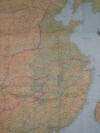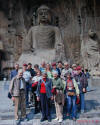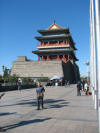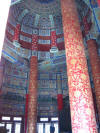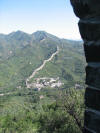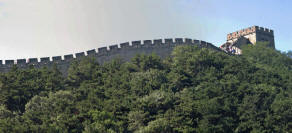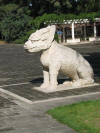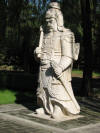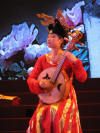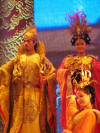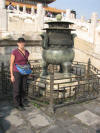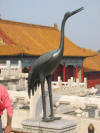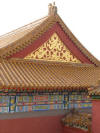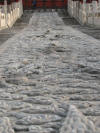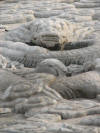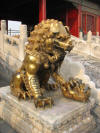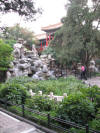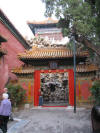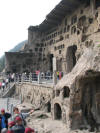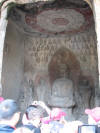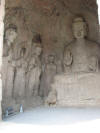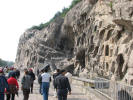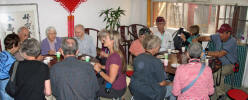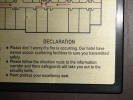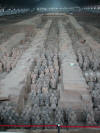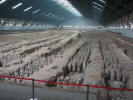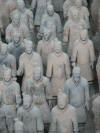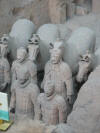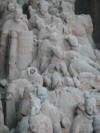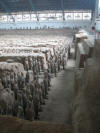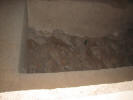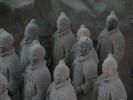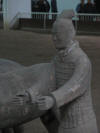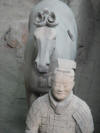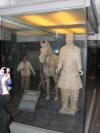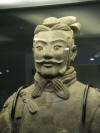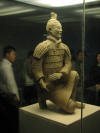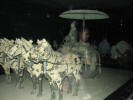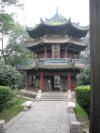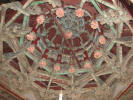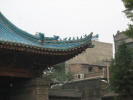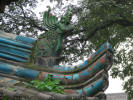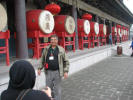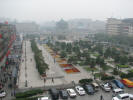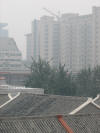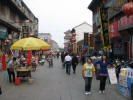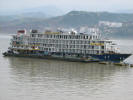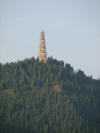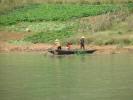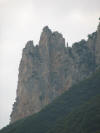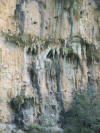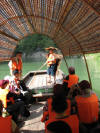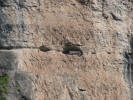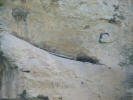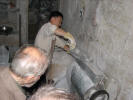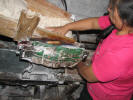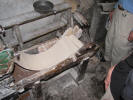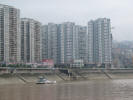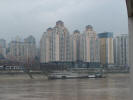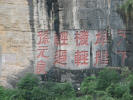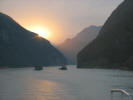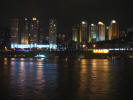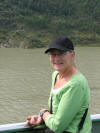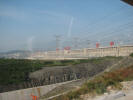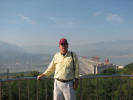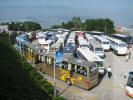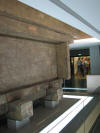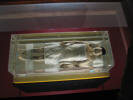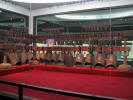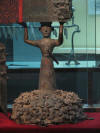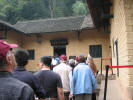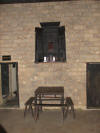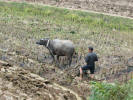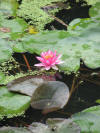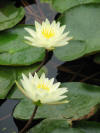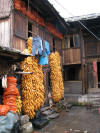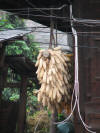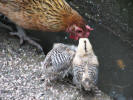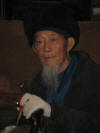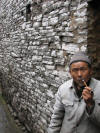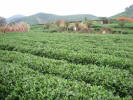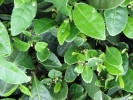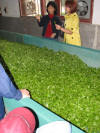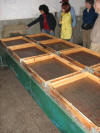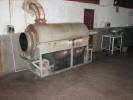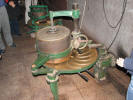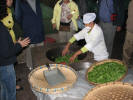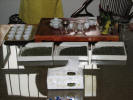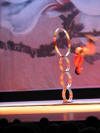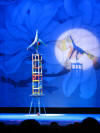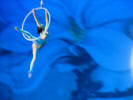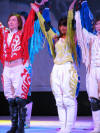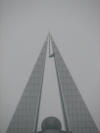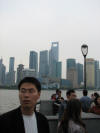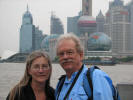welcome to worldwidewachs.com
CHINA - SEP 20 to OCT 15, 2010
This was the first post retirement trip overseas where there was no service component. We admitted after a couple of weeks there was something missing, something not right; but we thoroughly enjoyed ourselves anyway. This trip was a Roads Scholar (nee Elderhostal) trip starting in Beijing traveling to most of the wonders of China's past via bus, train, boat and just twice by air until we reached Shanghai. By traveling as we did we were able to enjoy scenic views as well as visit farms and villages where some things were unchanged by time and other things were surprisingly modern.
Hotel accommodations were excellent; very modern and comfortably familiar for a westerner. Breakfasts were buffet, most would be termed English breakfast. Lunch and dinner were served family style around the familiar round table with a central lazy Susan. There were 6-8 main dishes, some regional, some generic, but all Chinese. We learned that when the watermelon was served there would be nothing else coming. Roads Scholar said there could be no accommodation for vegetarians, but Martie did quite well regardless. We even went to vegetarian restaurants twice.
The schedule was hectic, so we made only a stab at keeping a journal. I shot lots of pictures, but many of our travel companions out shot me. Below I will display our trip chronologically. As always double click on a thumbnail if it appears fuzzy or you wish to see it full size.
Here is the map of where we travelled. And to the right is the group we went with. The oriental in the back row is our guide, Jai. He was excellent.
Beijing Area:
TOP: Tiananmen Square: Back of Ch. Mao's tomb, the line in front to enter, the expanse of the square.
BOTTOM: The Temple of Heaven showed the unique architecture, soaring columns and doodads on the eaves to protect the building and occupants.
Views from the Great Wall of China. We were at the Badaling section.
Walking through the 13 Ming tombs where the path was lined with statuary.
Following a tour of the gardens of Soong Ling, one of the original founders of the Party, we took a rickshaw ride through old living area called hutongs.
During our stay we saw several kinds of plays using Eastern instruments and elaborate costumes. The long sleeve dancer can hardly be seen until stopped by the camera.
From the moment I queued at the entrance of the Forbidden City until exiting hours later, I was in awe. The eave doodads above number 12, only the emperor could have that many. The detail of the facades is as wonderful as the bright colors.
The aptly named Largest Stone Carving is a river of dragons pouring down a stairway. It is a single stone monolith 17 x 3 x 1.7 meters weighing over 200 tons.
LUOYANG:
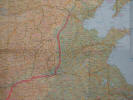 After leaving Beijing by train to Zhengzhou for 5-6 hours, we were rewarded with
a 3 hour bus ride to Luoyang.
After leaving Beijing by train to Zhengzhou for 5-6 hours, we were rewarded with
a 3 hour bus ride to Luoyang.
Here we visitedLongmen Grottos. Here the devout Buddhists have filled the cliff-side with statues ranging in size from 1" tall to the huge panoramic Buddha where the earlier seen group photo was taken.
A short break from the spectacular. Breakfast was in the hotel, but each lunch and dinner was served family style with a central Lazy Susan. Platters of various dishes came steadily. We learned that nothing more was forthcoming after the watermelon was served. The other thumbnail should be clicked and read. This was the best of several seen. Now exactly what are we to do in case of fire?!?
Xi'an:
Following another train ride, this time with berths which are more comfortable, we arrive in Xi'an, home to the Terra Cotta Warriors. These are the replicas of a king's personal defenders. They were to defend him in the afterlife. This building is huge! There has been a tremendous amount of work expended to put all this back together. The fifth and seventh pictures give a idea of how they were found. The kneeling guy ( next to last pic) is the only statue found undamaged so far. The rest have all been glued together. Each face is believed to be that of an actual member of the army.
In Xi'an we visited a mosque in a Muslim area. Note the interior detail of the tower as well as the eaves. There is a tall (135 steps) Drum Tower used in ancient times to signal folks. Most of China was in a perpetual smog as can be seen looking from the Drum Tower. Note the crane atop the high rise. The crane is now wryly referred to as China's national bird. Once on a corner construction site I counted 24 cranes! In the last picture we see the backs of Lin and Barney as they check out the local shopping district.
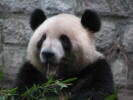
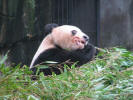
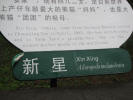 We sailed into the zoo to see the Pandas so close to closing that Pandas were
all we saw.
We sailed into the zoo to see the Pandas so close to closing that Pandas were
all we saw.
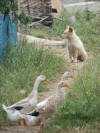
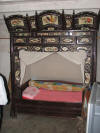
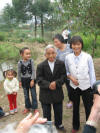 Several opportunities were taken to visit homes of villagers. Seen here is
a bedroom and the three generations living on this farm.
Several opportunities were taken to visit homes of villagers. Seen here is
a bedroom and the three generations living on this farm.
YANGTZE RIVER VOYAGE:
The river cruise between Chongqing and Changyan was delightful. By doing the most of the driving at night we were able to stop along the way to visit folks relocated by the Yangtze River Hydroelectric Dam project, see the sights and visit towns along the way. All along we spotted unusual buildings, sampans, various cliffs, towering palisades and other oddities to the Western eye. On a excursion up a tributary we rode a sampan where Lotte tried on a local garb and we passed coffins "buried" in natural or manmade niches on the cliff face.
Above is a noodle shop we visited while strolling down the street. Here the man loads a mixer, the woman feed the roller and the master noodle comes out to be cut into long strands and dried on a rack near the street. According to their certificate the Health Department had not been around for some five years. We cruised past what Jai called "villages". Anything the size of St Louis or below is a village to the Chinese. My preferred translation of the characters carved in the cliff is "Kilroy was here."
As we cruised east we got to enjoy the sun set from the upper deck. After dark some more "villages" showed their colors. At journey's end lay the Three Gorges hydroelectric dam, decades in the planning and another in the execution. Over half of the total cost was to relocate those displaced by the rising waters. The dam is rightfully an attraction of its own, but I spent 30 minutes watching the tiny bus parking lot. Although the vehicles changed constantly this picture remained representative. Needless to say there were people everywhere, mostly Chinese.
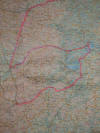 Now we travel the bottom line from east to west. From Gulyang we flew to
Shanghai for a few days before flying home.
Now we travel the bottom line from east to west. From Gulyang we flew to
Shanghai for a few days before flying home.
Changsha:
The Hunan Provincial Museum has the coffin and occupant on display. Those are solid single slabs of wood maybe four feet wide! The lady was buried more than 1000 years ago. The brass bells and a detail of the holder was also there. The group was able to speak with the curator as well.
Queuing outside Chairman Mao's family home. It was a simple structure, a typical farm for the times. A water buffalo was being used to turn the rice paddy outside and a tranquil lily pond attracted my attention.
This village had harvested their corn which was drying everywhere. There were the young chicks, the old man, and an ancient wall that was old when this man's great-grandfather was a kid. The family has lived there continuously.
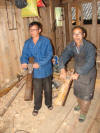
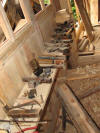
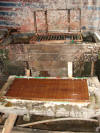
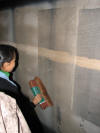
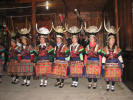
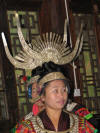
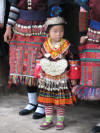 These carpenters seem to be using the old hand tools, but I saw several electric
saws, etc. about. The house was being built in a traditional fashion like
others around it. In this village was a family which has made paper for
several generations by organic, renewable means from Mulberry tree bark.
This paper is prized for its durability over centuries. At another nearby
village we enjoyed traditional dancing with exquisite costumes, but I have to
admit kid watching trumped all.
These carpenters seem to be using the old hand tools, but I saw several electric
saws, etc. about. The house was being built in a traditional fashion like
others around it. In this village was a family which has made paper for
several generations by organic, renewable means from Mulberry tree bark.
This paper is prized for its durability over centuries. At another nearby
village we enjoyed traditional dancing with exquisite costumes, but I have to
admit kid watching trumped all.
GUIYANG:
We visited a tea farm. First I learned that the tea "bush" is really a tree if not kept pruned. There are three prized pickings for green tea: single bud, bud & one leaf and bud & two leaves. Three experienced pickers can gather a bushel of buds in eight hours. The close-up of the bush here has been picked. There is natural air drying, forced hot air drying and rolling dryer shown. Then there is a machine for rolling the leaves, but this is done traditionally by hand as shown in the penultimate picture. Last we sit for a traditional tea service, are taught proper etiquette and get to taste (and buy) the three types of green tea.
SHANGHAI:
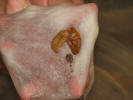
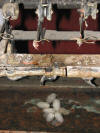
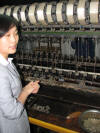
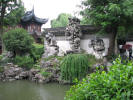
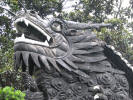
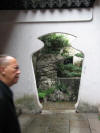
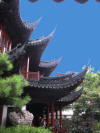 After flying to Shanghai we visited, in no special order here, a silk
manufacturer. Seen here are the pupa of the silk worm, a machine that
unwinds the pupa, which is made of a single unbroken strand, and winds the
strand on a spool. After a bit it turns into a very expensive article of
clothing or bedding. I first visited the Lu Gardens in 1999 while on a
business trip. I particularly wanted Martie to see this as I had been
quite impressed. We drew a drizzling, grey overcast day and with the crowds we
were not able to explore as much as I had done before. The snake-like
dragon covers the wall all around the garden. The dragon was reserved for the
emperor, so this may have been a gutsy move on the owner's part. I Photoshopped
the sky so you could see it on a good day.
After flying to Shanghai we visited, in no special order here, a silk
manufacturer. Seen here are the pupa of the silk worm, a machine that
unwinds the pupa, which is made of a single unbroken strand, and winds the
strand on a spool. After a bit it turns into a very expensive article of
clothing or bedding. I first visited the Lu Gardens in 1999 while on a
business trip. I particularly wanted Martie to see this as I had been
quite impressed. We drew a drizzling, grey overcast day and with the crowds we
were not able to explore as much as I had done before. The snake-like
dragon covers the wall all around the garden. The dragon was reserved for the
emperor, so this may have been a gutsy move on the owner's part. I Photoshopped
the sky so you could see it on a good day.
We were entertained by the Shanghai Circus one night. The cast taking bows just survived driving inside a steel mesh sphere in the dark on motorcycles at high speed.
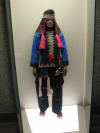
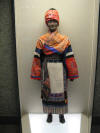
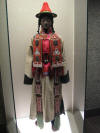
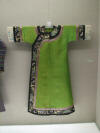
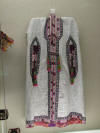
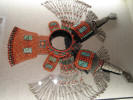
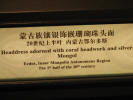 The Shanghai Museum had more stuff than we had time. We particularly
enjoyed the minority costumes and jewelry.
The Shanghai Museum had more stuff than we had time. We particularly
enjoyed the minority costumes and jewelry.
If you are out of work you might apply to wash windows in Shanghai. The panorama of the harbor is amazing when compared to my earlier memories. Most of the buildings were not there. The pointed topped building in front of the one with the "handle" on top was just finished and for a short time was the tallest in the world. It is now sixth and the other is second or third. Our guide Jai is hoping we will all show up on time, making his job easier. Guess what we asked him to do?
